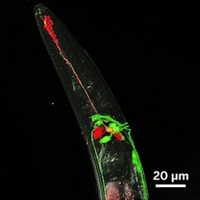Advertisement
Grab your lab coat. Let's get started
Welcome!
Welcome!
Create an account below to get 6 C&EN articles per month, receive newsletters and more - all free.
It seems this is your first time logging in online. Please enter the following information to continue.
As an ACS member you automatically get access to this site. All we need is few more details to create your reading experience.
Not you? Sign in with a different account.
Not you? Sign in with a different account.
ERROR 1
ERROR 1
ERROR 2
ERROR 2
ERROR 2
ERROR 2
ERROR 2
Password and Confirm password must match.
If you have an ACS member number, please enter it here so we can link this account to your membership. (optional)
ERROR 2
ACS values your privacy. By submitting your information, you are gaining access to C&EN and subscribing to our weekly newsletter. We use the information you provide to make your reading experience better, and we will never sell your data to third party members.
Biological Chemistry
Ion Channel Blocks Acid Pain
Neuroscience: Gated protein renders naked mole rats insensitive to low pH
by Lauren Wolf
January 3, 2012
| A version of this story appeared in
Volume 89, Issue 51
African naked mole rats, the only mammals known to be impervious to acid-related pain, should thank sodium channels in their neurons for the unique sensory trait, a new study suggests (Science, DOI: 10.1126/science.1213760). Understanding how the hairless, toothy rodents have evolved to handle the high levels of acid in their tissue might help scientists tackle human inflammatory conditions in which acidosis occurs.
To elucidate the molecular mechanism behind the mole rats’ acid insensitivity, Gary R. Lewin of Max Delbrück Center for Molecular Medicine, in Germany, and coworkers first compared the behavior of acid-sensing ion channels (ASICs) in the neurons of the hairless rodents with their behavior in mice. “At the beginning of the project, we thought that mole rats, which live underground in high-CO2 acidic environments, might not express ASICs or that the channels were somehow different,” explains postdoc Ewan St. John Smith. But the team found no significant differences between the ASICs in mole rats and mice.
Lewin’s group then closely investigated the voltage-gated sodium ion channel Nav1.7, the membrane protein that ultimately allows neurons to fire, in both animals. The researchers determined that in naked mole rats, acidic protons block Nav1.7. The hairless critters, the team found, have a negatively charged amino acid motif in one region of their Nav1.7 channels where mice—and humans—have a positively charged motif. The researchers think acidic protons might disable the sodium channel in mole rats by interaction with these negatively charged residues.

This “interesting finding,” says Cheryl L. Stucky, a neuroscientist at the Medical College of Wisconsin, might one day lead to a therapy for acid-related pain conditions, such as that caused by severe sickle cell disease. “If you could upregulate the channel to be inhibited by acid”—perhaps via small molecules or gene therapy—“you could put the brake on neuron firing during pain.”
The next step for his team, Lewin says, is to determine whether mice engineered with a copy of the naked mole rats’ Nav1.7 gene become insensitive to acid pain.




Join the conversation
Contact the reporter
Submit a Letter to the Editor for publication
Engage with us on Twitter